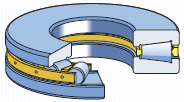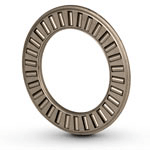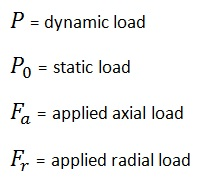Thrust Bearings Information
Thrust bearings have rolling elements which primarily support the axial loads of rotating devices. Several styles of bearings are available in thrust configurations.
Whereas radial-load bearings locate ball or roller races on the opposing inner and outer bearing rings, most thrust bearings have raceways machined into the faces of mating rings. This arrangement supports a load that is parallel to the bearing axis, but offers little to no support for radial loads. Thrust bearings are also inadequate to handle moment loads.
Balls, cylindrical rollers, tapered rollers, spherical rollers and needle rollers are the most common rolling elements used for thrust applications. Cages/retainers are almost always utilized to maintain uniform roller loading and spacing. Although fluid bearings and magnetic bearings are also manufactured for thrust applications, these areas are better addressed on their respective pages, but are herein identified as applicable.
Types of Thrust Bearings
Rolling element thrust bearings
Tapered Roller Thrust Bearing -- The angle created between the bearing axis and the line of contact between the raceway and the tapered roller determines the degree of thrust this bearing can accommodate. If this angle is greater than 45°, the bearing is better suited for axial loads. Once the angle between the bearing axis and roller axis reaches 90° the bearing can only sustain axial loads. These bearings require a cage, and sometimes a flange, to retain the roller assembly.
Heavy-duty tapered roller thrust bearings are also manufactured with a second row of opposing tapered rollers. By altering the shape of a raceway, this type of "screw-down" bearing resists mild or moderate angular misalignment.
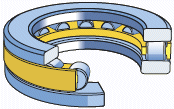
Cylindrical Roller Thrust Bearing -- This type of bearing fans the cylindrical rollers around the bearing axis in a perpendicular, radial fashion. These rollers must be crowned or end-relieved to reduce stress between the rollers and outer wall of the house washer raceway. They do not require much axial space to be deployed, and also come in double-row variations. While suitable for substantial axial loads, they are not recommended for a radial load.
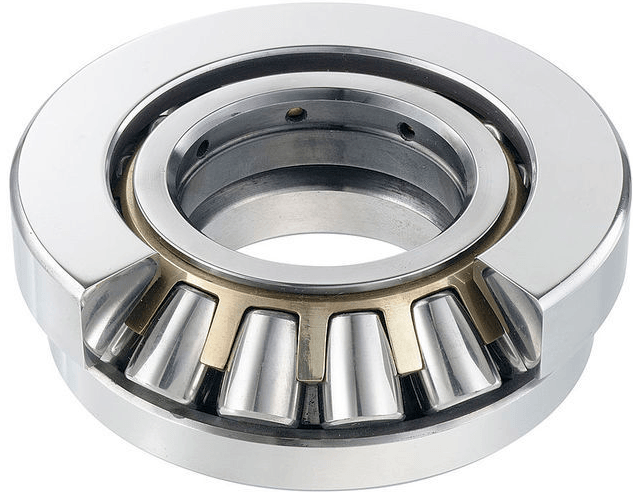
Spherical Roller Thrust Bearing -- The rolling elements are barrel-shaped and the raceways closely resemble the cone-and-cup design found in standard tapered roller bearings. This provides the bearing with self-aligning capabilities which is beneficial in applications where shaft deflection or shock loads can occur. They support heavy axial thrust in one direction (though variants exist for both directions), and can also tolerate moderate radial loads. As with tapered roller thrust bearings, the angle between the roller axis and the bearing axis determines the ratio of axial/radial loading.
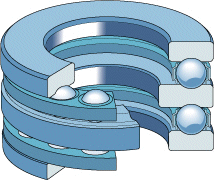
Thrust Ball Bearing -- Thrust ball bearings cannot transmit any radial loading. This type is susceptible to misalignment, and manufacturers frequently include a sphered groove on the housing washer to reduce this possibility. While excellent for high speed applications, their performance suffers under heavy loads.
Needle Roller Thrust Bearing -- Needle roller thrust bearings are valued for their minimal height and high number of rolling elements. As such, they are occasionally implemented without a shaft or housing washer; when suitable the rolling elements are in direct contact with the rotating components. These can accommodate very high axial and shock loads, but absolutely no radial load.
Comparison table
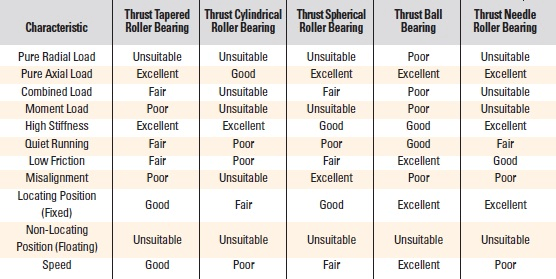
The accompanying table illustrates the relative capabilities of thrust bearings.
Table credit: Timken
Fluid-film thrust bearings
Fluid-film bearings are valued in high-speed, high-load applications. They are typically less expensive than rolling element-type bearings, and have exceptionally long working lives.
Hydrodynamic
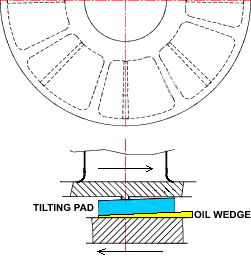 A robust lubricant or air cushion under high pressure supports the axial load, due to bearing geometry and lubricant viscosity. During rotation, the fluid is drawn to the bearing pad and creates a minimal-friction fluid buffer. The load is supported on wedges of fluid created by the pad's geometry. Seals and a special type of cage are needed to maintain lubricant pressure and dispersion, respectively. Hydrodynamic bearings can suffer from high torque, high minimum loads, and excessive bearing inertia, but this is largely dependent on the type of fluid used.
A robust lubricant or air cushion under high pressure supports the axial load, due to bearing geometry and lubricant viscosity. During rotation, the fluid is drawn to the bearing pad and creates a minimal-friction fluid buffer. The load is supported on wedges of fluid created by the pad's geometry. Seals and a special type of cage are needed to maintain lubricant pressure and dispersion, respectively. Hydrodynamic bearings can suffer from high torque, high minimum loads, and excessive bearing inertia, but this is largely dependent on the type of fluid used.
Hydrodynamic bearings are manufactured with a tilting pad, which permits uneven thrust loads across the bearing, but maintains the fluid seal despite this misalignment.
Hydrostatic
In this instance the lubricant or air cushion is pumped through the bearing assembly to maintain positive pressure. This overcomes some of the inertia and torque problems experienced by hydrodynamic bearings, but this assembly requires a continuously operating pump which should be factored into the bearing's energy efficiency. Hydrostatic bearings which utilize an air cushion have tolerances as low as 0.2 μm, making them the ideal choice for precision machining.
Magnetic thrust bearings
These types of thrust bearings support loads by magnetic levitation. Permanent magnets are suitable for light loads, but electromagnets are required for moderate to heavy loads--powered types of magnetic bearings are referred to as "active." Some magnets are outfitted with both permanent magnets and electromagnets to support static and dynamic loads, respectively. Magnetic bearings are extremely low friction devices which do not need lubrication. With some exceptions, they are also maintenance-free. This type of bearing does not support misaligned loads.
Specifications
Dimensional space and bearing envelope
Bearing geometry, identified in metric or imperial units, must equate to the application's housing allocation.
-
Shaft washer diameter is the measurement across the bore hole, which is the interface for a shaft. This equates to the inner diameter of a non-thrust bearing.
-
Housing washer diameter is the straight-line measurement between antipodal points on this component, which is engraved with a raceway for rolling elements.
-
Width is the measurement across the bearing side which is parallel to the shaft axis; this can also been viewed as the "height" of the bearing.
Operational parameters
Minimum load
To stably operate at high speeds, the bearing must have a minimum load applied to rolling elements and raceways. This prevents damage to internal components from excessive friction. The following table provides formulas to determine this for each of the basic thrust bearing-types.
| Tapered roller thrust bearing |  |
 |
| Cylindrical roller thrust bearing |  |
|
| Spherical roller thrust bearing |  |
|
| Thrust ball bearing |  |
|
| Needle roller thrust bearing |  |
Dynamic and static thrust load
Dynamic load represents the mechanical burden on the bearing while in operation, while static loading is the burden experienced by the bearing while at rest. In most instances, the applied thrust load is equal to both the dynamic and static load. Both specifications are important to thrust bearing selection, and also help determine the expected bearing lifespan.
|
Thrust bearing type |
Equivalent dynamic load |
Equivalent static load |
Key |
| Tapered roller |
|
|
|
| Cylindrical roller | |||
| Needle roller | |||
| Ball | |||
| Spherical roller |
Lifespan
After determining some of the above dynamic load values, the lifespan of the bearing becomes calculable.
|
Thrust bearing type |
Lifespan |
Key |
| Cylindrical roller |  |
 |
| Needle roller | ||
| Ball | ||
| Spherical roller | ||
| Tapered roller |  |
Since fluid and magnetic bearings offer friction-free rotation, their lifetimes are virtually indefinite.
Operating temperatures
The acceptable operating temperature is determined by the equipment requirements, potential lubrication and service limitations of the bearing, the bearing materials, and the service life expected. A bearing's equilibrium temperature is the temperature under which heat is created in the bearing at the same rate it is exhausted. However, this is an ideal and not practical for many applications. Heat is accumulated by friction in the bearing, ambient environmental temperatures, and other heat-producing machinery. Heat is dissipated by lubricants, the materials and masses of the bearing, the surface area of the bearing, and the exchange of air within bearing components.
Precision tools will be highly affected by thermal expansion, but most industrial equipment is less sensitive. Transient conditions will peak temperatures before stabilizing, due to uneven heating across bearing components. New bearings will also produce very high temperatures before "breaking in."
Most standard bearing steels cannot sustain temperatures above 275° F, but manufacturers will temper steel for suitable applications, raising the steel's temperature threshold to 800° F. Above this temperature, cobalt alloys express resistance to thermal changes and oxidation.

Torque
Bearing torque can be attributed to several variables, such as roller size, the number of rollers, cage composition, bearing tolerances, lubricant type and fill, and the bearing's load. Bearing torque is classified into three categories.
-
Starting torque is the measurement of the torque required to initiate rotation of one raceway of the bearing. This is substantially higher than running torque.
-
Average running torque is the mean level of torque the bearing is subjected to at a consistent RPM.
-
Peak running torque is the maximum amount of torque experienced by a bearing, but can be difficult to determine. This provides a measure of consistency for a batch of bearings.
Fluid bearings face a minimal amount of initial torque and almost no running torque. The sole factor which determines torque is the viscosity of the lubricant; air-cushioned bearings face negligible inertial resistance. Magnetic bearings experience no torque.
Components
Mechanical bearings
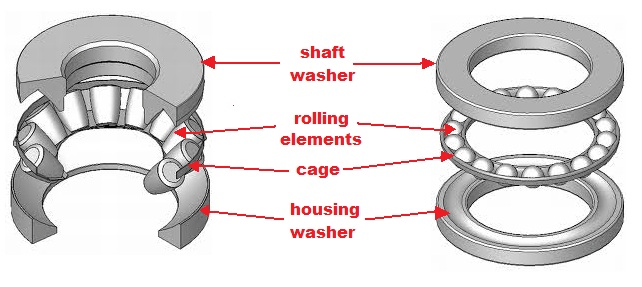
-
The housing washer is engraved with a deep groove to guide the rolling elements. This component is equivalent to the outer raceway of a radial bearing, and is meant for installation with the non-rotating component of the assembly. Most housing washers can only accommodate thrust in one direction.
-
A metal flange (not pictured) is frequently incorporated to prevent high-inertia rollers from exiting the raceway.
-
Seals (not pictured) prevent the ingress of moisture and debris into the raceway, as well as the egress of lubricant. They are typically made of rubber, polyurethane, or metal, and may be of the contact or non-contact variety.
-
-
Rolling elements are the friction-reduction mechanisms which provide reliable rotary motion. Rolling elements may be of the ball or roller (tapered, spherical, cylindrical, needle) variety. These are the primary load-carrying structures.
-
A cage retains rolling elements within an assembly, and arranges them around the raceway to maintain even load distribution. Cages are sometimes optional with radial bearings, but nearly all thrust bearings require one.
-
The shaft washer interfaces with the rotating component of the assembly. It is equivalent to the inner ring of a radial bearing.
-
Lubricant (not pictured) prevents the metal-on-metal contact for bearing components, thereby reducing wear, friction, heat, and noise. However, regular relubrication is required for 'wet' lubricants via lubrication holes in the housing washer. Lubricant types include:
-
Oil: Options include synthetic oils (moderate loads and speeds), petroleum oils (excellent lubrication for high loads), mineral oils (moderate loads, high speeds) and silicone oils (heat resistant, rubber-safe, low speeds).
-
Grease: Offer minimal running torque, but high starting-torque lubrication. They are best used at high speeds.
-
Dry films: Should only be used where 'wet' lubricants are unsuitable. Dry films will eventually flake and obstruct rotation.
-
Fluid-film bearings
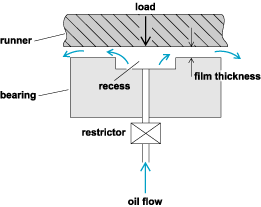 Hydrodynamic bearings resemble the hydrostatic bearing depicted at right, but do not utilize a pump.
Hydrodynamic bearings resemble the hydrostatic bearing depicted at right, but do not utilize a pump.
-
Runner/pads: this is the load-bearing, rotary component of the bearing assembly. This component remains afloat in hydraulic oil or an air cushion.
-
Fluid layer: the distance between the runner/pads and the housing, that is created by the pressure of the fluid.
-
Housing: this is installed as the non-rotating component of the bearing, and an internal recess routs fluid between the housing and runner or pads.
-
Seals: these help maintain the internal pressure of the bearing. Quality seals are the main reason hydrodynamic bearings function without a pump.
-
Restrictor (hydrostatic only): a valve which regulates the fluid flow rate through the housing.
-
Pump (hydrostatic only): this creates the pressure that supports the pads via a fluid.
Magnetic bearings
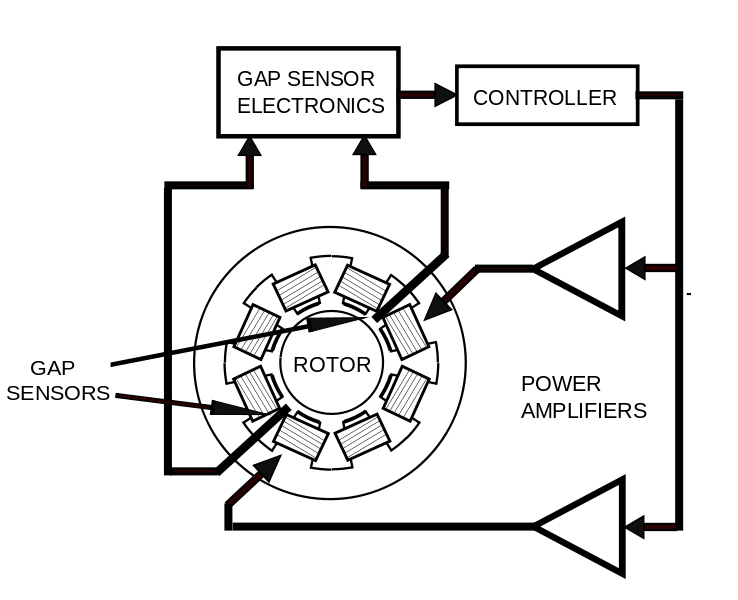 The electromagnetic bearing pictured at right supports radial loads, but the operation of an electromagnetic thrust bearing remains similar. Permanent magnet thrust bearings rely on the repulsion of like poles to support a light load, and do not require circuited components.
The electromagnetic bearing pictured at right supports radial loads, but the operation of an electromagnetic thrust bearing remains similar. Permanent magnet thrust bearings rely on the repulsion of like poles to support a light load, and do not require circuited components.
-
Rotor: the load-bearing surface of the magnetic bearing, which rotates about the stator.
-
Stator: the stationary raceway of the bearing, which is outfitted with electromagnets when appropriate.
-
Amplifiers: supply current to the electromagnets located on opposite sides of the rotor.
-
Controller: regulates current supply to control bearing speed and positioning.
-
Gap sensors: provides feedback to the controller regarding the rotor speed and positioning.
Features
-
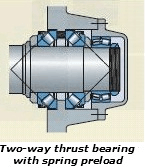 ABEC rated: the ball bearing's precision and accuracy has been evaluated based on North American industry guidelines, which establishes five ratings, each with an exceeding guarantee of precision and tolerance. They are: ABEC 1, ABEC 3, ABEC 5, ABEC 7, and ABEC 9.
ABEC rated: the ball bearing's precision and accuracy has been evaluated based on North American industry guidelines, which establishes five ratings, each with an exceeding guarantee of precision and tolerance. They are: ABEC 1, ABEC 3, ABEC 5, ABEC 7, and ABEC 9. -
Auxiliary rollers: a magnetic bearing includes rollers or bushings to prevent the stator and rotor from contacting when not charged.
-
Ceramic/cermet: balls are made of ceramic or composite material, which improves reliability, precision, and several other key factors. They are common in electric motors.
-
Combined load: the thrust bearing can accept a minority radial load.
-
Condition monitoring: the bearing design lends itself to automated inspection via equipment, which determines when bearing operation has been compromised.
-
Heat treated: the bearing's thermal tolerance is improved via a post-manufacturing process.
-
ISO rated: the ball bearing has been compared to ISO 492, which establishes a bearing rating hierarchy, Ranked least to most efficient: Class 6x, Class 6, Class 5, Class 4, and Class 2.
-
Plated: the bearing receives a metallic overlay, such as cadmium or chrome.
-
Preloaded: the bearing interfaces with a spring mechanism which ensures the minimum load is always present.
-
Separable: the bearing can be segmented to aid installation and maintenance.
-
Self-aligning: the bearing rollers and raceways can accommodate a limited degree of misalignment.
-
Two-way: the bearing can support axial loads in both directions, which is usually accomplished with a second complement of rolling elements and a thrust washer.
-
Uninterruptable power supply (UPS): the bearing pump or electromagnet has an emergency power supply.
Standards
The accompanying standards often guide manufacturers during bearing production, and may offer worthwhile information during bearing selection.
ABMA 12240-3 - Spherical roller thrust bearings
ABMA 23.2 - Design of tapered roller thrust bearings
ABMA 24.2 - Design of ball and cylindrical roller thrust bearings
ABMA 104 - Roller thrust bearings dimensions
ABMA 199 - Roller thrust bearings tolerances
Resources
Syncrony—Magnetic bearing terminology
Springer Reference—Hydrostatic thrust bearing
Machine Design—Hydrodynamic bearings
Zollern—Accuracy to the micrometre. Hydrostatics and aerostatics...
SKF—Bearings, units, and housing
Image credits:
SKF | NTN | National Precision Bearing | Marine Diesels | Wikimedia | Central-Lube Technology Co.
- ABEC 1 / RBEC 1 / Class 0 / P0
- ABEC 5 / RBEC 5 / Class 5 / P5
- ABEC 7 / RBEC 7 / Class 4 / P4
- ABEC 9 / RBEC 9 / Class 2 / P2
- Ceramic Balls
- Cylindrical Roller Thrust
- Flat Race Thrust Ball
- Grooved Race Thrust Ball
- Inch
- Metric
- Needle Roller Thrust
- Plastic
- Plated
- Polymer
- Spherical Roller Thrust
- Stainless Steel
- Steel
- Steel - Stainless
- Tapered Roller Thrust
- Thrust Washer
- Two Directional Grooved Thrust
- Unground Bearing
- thrust bearing application
- radial thrust bearing
- tapered roller thrust bearing
- banded thrust bearings
- heavy duty thrust bearings
- magnetic thrust bearings
- babbitt thrust bearings
- bronze thrust bearings
- ceramic thrust bearings
- PTFE thrust bearings
- sealed thrust bearings
- turntable thrust bearings
- vertical thrust bearings
- self aligning thrust bearings
- 360 degree thrust bearings
- 4 bolt flange thrust bearings
- 51100 thrust bearing
- 51101 thrust bearing
- 51102 thrust bearing
- 51103 thrust bearing
- 51105 thrust bearing
- 51106 thrust bearing
- 51107 thrust bearing
- 51108 thrust bearing
- 51202 thrust bearing
- 51203 thrust bearing
- 51205 thrust bearing
- 51206 thrust bearing
- 51207 thrust bearing
- 51208 thrust bearing
